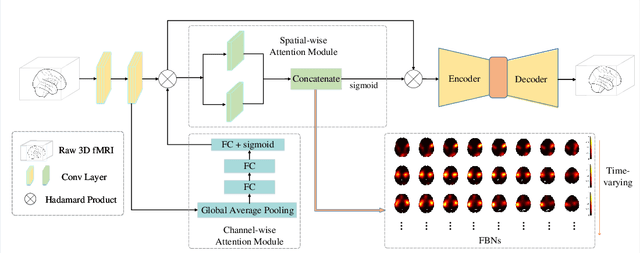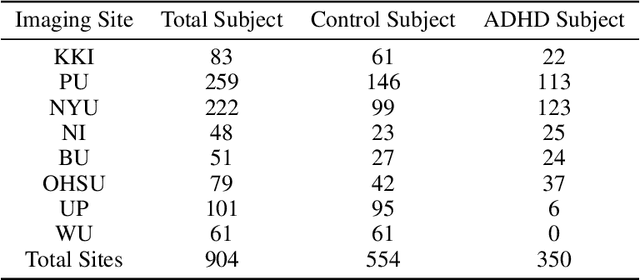Enjie Ge
Spatial-Temporal Convolutional Attention for Mapping Functional Brain Networks
Nov 04, 2022Abstract:Using functional magnetic resonance imaging (fMRI) and deep learning to explore functional brain networks (FBNs) has attracted many researchers. However, most of these studies are still based on the temporal correlation between the sources and voxel signals, and lack of researches on the dynamics of brain function. Due to the widespread local correlations in the volumes, FBNs can be generated directly in the spatial domain in a self-supervised manner by using spatial-wise attention (SA), and the resulting FBNs has a higher spatial similarity with templates compared to the classical method. Therefore, we proposed a novel Spatial-Temporal Convolutional Attention (STCA) model to discover the dynamic FBNs by using the sliding windows. To validate the performance of the proposed method, we evaluate the approach on HCP-rest dataset. The results indicate that STCA can be used to discover FBNs in a dynamic way which provide a novel approach to better understand human brain.
Discovering Dynamic Functional Brain Networks via Spatial and Channel-wise Attention
May 31, 2022



Abstract:Using deep learning models to recognize functional brain networks (FBNs) in functional magnetic resonance imaging (fMRI) has been attracting increasing interest recently. However, most existing work focuses on detecting static FBNs from entire fMRI signals, such as correlation-based functional connectivity. Sliding-window is a widely used strategy to capture the dynamics of FBNs, but it is still limited in representing intrinsic functional interactive dynamics at each time step. And the number of FBNs usually need to be set manually. More over, due to the complexity of dynamic interactions in brain, traditional linear and shallow models are insufficient in identifying complex and spatially overlapped FBNs across each time step. In this paper, we propose a novel Spatial and Channel-wise Attention Autoencoder (SCAAE) for discovering FBNs dynamically. The core idea of SCAAE is to apply attention mechanism to FBNs construction. Specifically, we designed two attention modules: 1) spatial-wise attention (SA) module to discover FBNs in the spatial domain and 2) a channel-wise attention (CA) module to weigh the channels for selecting the FBNs automatically. We evaluated our approach on ADHD200 dataset and our results indicate that the proposed SCAAE method can effectively recover the dynamic changes of the FBNs at each fMRI time step, without using sliding windows. More importantly, our proposed hybrid attention modules (SA and CA) do not enforce assumptions of linearity and independence as previous methods, and thus provide a novel approach to better understanding dynamic functional brain networks.
 Add to Chrome
Add to Chrome Add to Firefox
Add to Firefox Add to Edge
Add to Edge